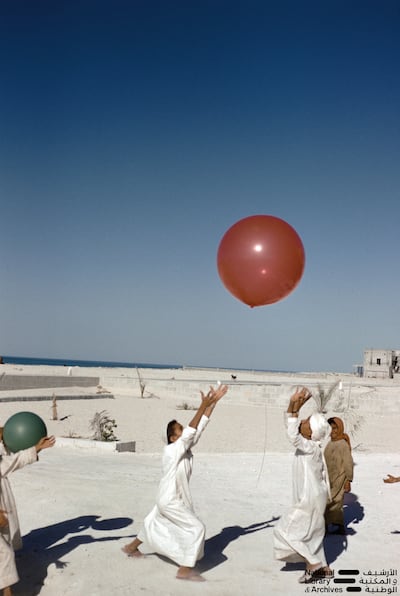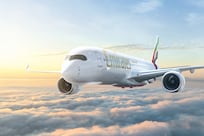Related: How the UAE is safeguarding its history in huge recording drive
At first glance, it is simply a camel train carrying a cargo of firewood across a water channel.
A tower guards the crossing, while the sea and sky project a timeless world of endless blue.
But this was a world about to experience torrents of change barely comprehensible to anyone living there then.
This image was taken in Abu Dhabi in the early 1960s and it shows the Al Maqta causeway that crossed the strait of water separating Abu Dhabi island from the mainland.
This was Abu Dhabi’s link to the rest of modern-day UAE and, before the causeway was built, could only be crossed safely at one point and at low tide.
The striking photograph was taken by oil engineer, Alan Horan, who had arrived in the spring of 1960.
Two years earlier Abu Dhabi had struck oil. Change was coming. But the town was experiencing an interlude before life would be transformed beyond all recognition.
But the photo itself already shows flickers of the changes that were coming. The causeway of stone blocks on which the camels walk was only built just a few years earlier to allow easier access for vehicles to pass without having to wait for low tides as the oil exploration drive gathered pace.
"My recollection is that I did not specifically set out to photograph the Maqta crossing," Mr Horan told The National. "I must have been on a journey or just exploring the island."
Abu Dhabi in the old days

Mr Horan, who was born in Egypt and earned a PhD in the UK, was appointed the chief local representative for Abu Dhabi Marine Areas Limited oil company, which had made that first discovery in 1958. He recalls a place practically untouched by development.
“Abu Dhabi was an island surrounded by creeks with extensive and beautiful coral reefs,” Mr Horan, who said he lived in a compound on the western side of Abu Dhabi, told The National.
"In those days there was nothing beyond us with Saadiyat Island in the distance."
Mr Horan, now in his 90s and living back in London, recalled how in those days with strong north-westerly winds and high tide, the sea would flood the areas immediately by the shoreline, surrounding buildings with water.
“This was particularly disruptive in the area where cargoes were discharged,” he recalls. “The ‘jetty’ was formed of barrels filled with cement. Delivering cargoes was complicated by the shallow waters in the immediate vicinity of the town which prevented cargo vessels approaching the jetty.
“For the greater part, the dwellings were of the ‘barasti’ style using palm fronds on wooden frames. Some houses were made of coral and mud. While the traditional business of pearl fishing had long passed, the craft of boat building and maintenance remained strong.”
Travelling to the mainland meant crossing the causeway he photographed and navigating a “treacherous” expanse of wet sabkha beyond that had often trapped camels in the mud.
The photographs Mr Horan shot during this time in Abu Dhabi are truly remarkable. Many were taken on a Zeiss Contessa camera that he bought in the Kuwait souq and then developed on Kodachrome slides injecting them with vibrancy and colour. They show a traditional way of life but also many pointed to the changes that were coming.

One shows young falconers gazing proudly into the camera, another shows a family of young women and girls outside their traditional barasti home, while another playful shot shows children playing with balloons outside the ADMA house.
One striking aerial photograph shows the causeway from where Mr Horan took the photograph of the camel train but beyond is an untouched world of creeks, inlets, channels, sea and sand. Another aerial shot of what is now the Corniche shows a practically untouched expanse of sand all the way down to Saadiyat Island.
Visits to Al Ain and its mountain spring water
Abu Dhabi was then ruled by Sheikh Shakhbout who Mr Horan describes as “gracious, supportive and kind”. During the summer, when Sheikh Shakhbout spent time in the drier climate of Al Ain away from the Abu Dhabi humid summer, Mr Horan would often visit him there as part of his duties with ADMA. Today, the journey is around 90 minutes by car on a new motorway, but then it involved an overnight camp amid rolling sand dunes.
“These night stops were exceptional occasions as there was complete silence and no light pollution. Unique,” said Mr Horan.
“In the morning, we proceeded to Al Ain where I met with Sheikh Shakhbout. Al Ain offered delights of clear water in the falajes – even a cool pool belonging to a local dignitary.
“Al Ain had extensive walled palm groves, fed by the falaj water. Water was always precious and the falaj water was of high quality and drinkable at the point of discharge from the mountains,” said Mr Horan.
“In Abu Dhabi, only very brackish water was available from local wells. So, water was imported from Dubai, in steel tanks aboard dhows. Even this water was not very potable, merely an improvement on the brackish water available locally.”
Dubai Creek and a trip to Liwa
Mr Horan also travelled across the country from Dubai to the Liwa oasis. An image taken in Dubai Creek shows abras, an intriguing selection of adverts for goods such as 7-up and various cigarette manufacturers, along with an impressive range of cars including Land Rovers. The Land Rover was a popular choice, particularly those trips to Liwa.
Mr Horan took several striking images of Liwa that showing its oases and vast desert. One in particular, of Mr Horan’s wife, Jean, walking through a date palm grove conveys the sheer vastness of the desert
“Liwa Oasis was accessible only by Land Rover and expert driving over dunes,” he said.
“Liwa was remarkable for its isolation from the rest of … Abu Dhabi. The residents were very hospitable.”
Crucial phase in country's history
Mr Horan left Abu Dhabi in 1962, the same year the first shipments of oil left for international markets. He returned for a second time in the 1970s as general manager of ADMA-OPCO before leaving in the early 1980s.
Mr Horan had an important role in the early development of Abu Dhabi’s oil industry. He returned as a guest for the 25th anniversary of the first export of oil and he was awarded an OBE for services to British commercial interests in Abu Dhabi.
Now he has donated his remarkable collection of more than 200 photographs from his time here to the UAE’s National Library and Archives.
They have been restored carefully, are safeguarded for future generations and can be viewed online on the Arabian Gulf Digital Archive. They are a truly special visual record of a crucial phase in Abu Dhabi’s history.
"I am honoured that my slides showing some aspects of those early days are now in the National Library and Archives," said Mr Horan.
"The periods spent in Abu Dhabi ... were essential parts of my career. I have very fond memories of my time serving Abu Dhabi."






















